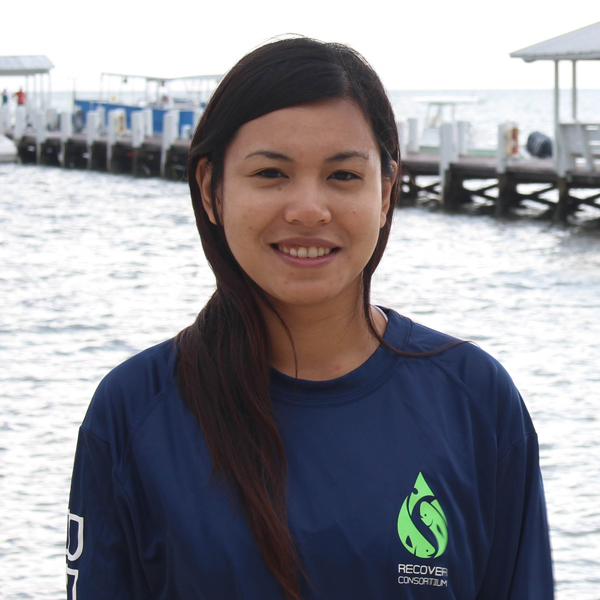Study finds slick oil has greater impact than source oil on fish development
Original Story by Nilde Maggie Dannreuther and Stephanie Ellis
For questions, comments or more information contact maggied@ngi.msstate.edu

Study author Graciel Diamante (a Ph.D. student at the University of California Riverside’s Department of Environmental Sciences at the time of this study and now a post-doctoral researcher at University of California Los Angeles), studied how oil exposure, like what happened during the Deepwater Horizon incident, affected early-life-stage Mahi-mahi. Credit: RECOVER consortium.
Scientists analyzed effects from non-weathered source oil (collected directly over the Deepwater Horizon wellhead) and weathered slick oil (collected from surface skimming) on the microRNAs of mahi-mahi embryos. MicroRNAs play a key role in regulating gene expression of messenger RNAs (mRNAs), which are involved with embryonic and larval development. The experiment found that both oil types can alter microRNA expression. However, slick oil produced a more-pronounced change in microRNA expression that is consistent with previously reported toxic effects and with messenger RNA regulation in mahi-mahi. Further analyses of slick oil impacts predicted a disruption in cardiovascular development and identified specific microRNA-messenger RNA interactions that correlated with decreased gene expression involved with heart and eye formation. Linking potential oil spill effects on fish microRNAs and messenger RNAs may provide a biomarker of heart development/function to assess oil impacts on fish.
The researchers published their findings in Environmental Science & Technology Letters: Differential expression of microRNAs in embryos and larvae of mahi-mahi (Coryphaena hippurus) exposed to Deepwater Horizon oil.
The oil spill’s timing and location overlapped with the mahi-mahi spawning season. Recent studies reported that polycyclic aromatic hydrocarbons (PAHs) associated with Deepwater Horizon oil may negatively affect mahi-mahi’s cardiac development and the expression of messenger RNA molecules, which play a key role in various biological processes (for example, Environmental Science & Technology Xu et al., 2016 and Scientific Reports Xu et al., 2017). This study sought to learn if impacts differed between weathered slick oil and nonweathered source oil.
“The effects of oil on developing fish is complex,” explained study author Daniel Schlenk. “Oil causes sublethal effects that may not be observed until after the fish develop. They may appear normal but have organs (i.e. eyes) that are not normal and show diminished function.”
The team conducted laboratory exposure experiments using mahi-mahi embryos and diluted high-energy water accommodated fractions (HEWAFs 1:1,000 dilutions of oil) of source and weathered slick oil. HEWAF preparations were as described in Environmental Science & Technology Mager et al., 2014 funded by the Natural Resource Damage Assessment (NRDA). Author Martin Grosell noted that HEWAF PAH data were compared with field sample PAH data generated with the larger NRDA field sampling program (described in PNAS Incardona et al., 2014) and that “these profiles are indistinguishable from those obtained from samples collected in the field during the spill.”
The team sampled microRNA and messenger RNA in surviving embryos and larvae at developmental milestones: heart tube formation, when the ventricle and atrium become discernable, and when larvae have undergone morphogenesis and are free-swimming. The annotated the microRNA libraries constructed from each sampling pool using two methods, one that aligns sample microRNAs with the Fugu rubripes or Japanese pufferfish genome and another that aligns sample microRNAs with known mature animal microRNAs.
“Many of the methods we used have been used in human studies, but this was one of the first studies to carry out these methods in fish,” explained Schlenk. “Of particular novelty was using a software [ingenuity pathway analysis or IPA] to evaluate the relationships between the different RNAs (microRNAs control the expression of messenger RNAs).”
Schlenk said that the oil’s complex effects on developing fish include a specific process involving microRNAs that control gene expression involved with heart and eye formation. “These effects appear to happen simultaneously, which is significant because some researchers think oil’s effects on fish embryos happen after it affects the heart. These data clearly show that at least the ocular effects happen at the same time.”
Schlenk said that potentially using microRNAs as a biomarker of fish heart development and function in oil impact studies is possible, especially since it is already used to assess human heart function.
Data are publicly available through the Gulf of Mexico Research Initiative Information and Data Cooperative (GRIIDC) at doi:10.7266/N70Z71QJ.
The study’s authors are Graciel Diamante, Elvis Genbo Xu, Shuai Chen, Edward Mager, Martin Grosell, and Daniel Schlenk.
By Nilde Maggie Dannreuther and Stephanie Ellis. Contact maggied@ngi.msstate.edu with questions or comments.
************
This research was made possible in part by a grant from the Gulf of Mexico Research Initiative (GoMRI) to the Relationship of Effects of Cardiac Outcomes in Fish for Validation of Ecological Risk (RECOVER)consortium.
The Gulf of Mexico Research Initiative (GoMRI) is a 10-year independent research program established to study the effect, and the potential associated impact, of hydrocarbon releases on the environment and public health, as well as to develop improved spill mitigation, oil detection, characterization, and remediation technologies. An independent and academic 20-member Research Board makes the funding and research direction decisions to ensure the intellectual quality, effectiveness and academic independence of the GoMRI research. All research data, findings, and publications will be made publicly available. The program was established through a $500 million financial commitment from BP. For more information, visit http://gulfresearchinitiative.org/.
© Copyright 2010-2019 Gulf of Mexico Research Initiative (GoMRI) – All Rights Reserved. Redistribution is encouraged with acknowledgment to the Gulf of Mexico Research Initiative (GoMRI). Please credit images and/or videos as done in each article. Questions? Contact web-content editor Nilde “Maggie” Dannreuther, Northern Gulf Institute, Mississippi State University (maggied@ngi.msstate.edu).




